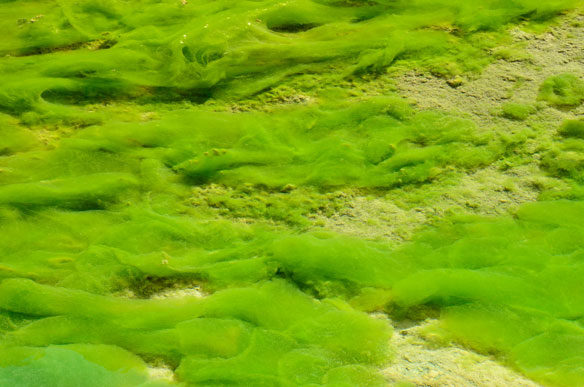
Photo source: ©© Tristan Schmurr
The second life of green algae
English Translation
Harmful when covering the beaches, green algae can be valued. If the application on fields for fertilization purposes, remains the largest market, other sectors are growing.
No less than 60,000 m3 of green algae have been collected in Britain last year. It is a huge slap for the communities in charge of coastal cleanup, a terrible hindrance for the tourism industry, as tourists have fled the beaches. But what happens to these tons of plants once removed from the beaches? Several options exist to benefit from this invasive material.
An effective fertilizer
The spreading is the main outlet of Ulva lactuca and concerns 80% of the collected “green lettuce”. This technique involves depositing fresh seaweed, rich in nitrogen, on the agricultural parcels as fertilizer. It is effective and inexpensive as no prior treatment is required. The method has its limitations, however: the transfer from the beach to the land must be fast, to keep the algae’s freshness. For this very reason, the destination should not be too far from the pickup location. At La Lieue de Grève in, les Côtes d’Armor, “the trucks do not go beyond a 25 km radius” says Briant Gwenaëlle, coordinator of the local watershed.
The farmer using this type of fertilization is also required to sign an agreement to carefully monitor all added levels of nitrogen induced by algae, and to record these levels in order to respect the soil pH, said Gwenaëlle Briant. For the same reason, the same parcel may be fertilized with green algae only once every five years.
The other major outlet for Ulva is to be mixed with other green plants to produce compost. It is a more expensive solution as external service providers are necessary. Nevertheless, this solution is particularly popular in the late spring, when fertilization is not possible in the fields covered with crops. Composting green algae however, has the advantage of giving an economic value to a free commodity. And contrary to traditional fertilization, the compost can be used by everyone without constraints.
A difficult product to capitalize on
Interesting from a composition standpoint , however, algae are difficult to use at the industrial level, since their production is irregular and unpredictable. And many challenges exist in their treatements .
They must be treated within 3-4 days after reaching the beach to avoid rotting. They are hardly transportable since they contain so much water. Sand also must be removed after algae are picked up on the beach, a tricky process. But once reduced to flour consistency or cake, the ulva sees its value explode: 2000-3000 per ton.
Once “stabilized” green algae is eligible for a number of industrial processes. The green algae may be used in the manufacture of many products. Cosmetics, chemicals, materials such as cardboard or plastics, food for animals, even for humans.
Another possible avenue, is production of energy. “The process of methanation, in which the algae, in contact with bacteria, give off gas and thus produce energy, is already studied in Japan. The problem is that its performance is not great and it emits sulfur, corrosive to the facilities, “said Yannick Lerat. The production of bioethanol, a fuel made of green algae, is also the subject of several investigations in France. “For now, the yield is only 10 or 20%. It should be up to 50%, “notes the expert.
Investments remain limited in this area because “it is difficult to build an industry on a resource where eradication is ultimately sought after ” says Yannick Lerat. “We prefer to invest in preventive action, but a business model is beginning to emerge.” The key to success, however, relies on the coordination of actions by various local authorities, says he. “What is lacking is a supply chain organization. If everyone does things in his corner, it does not take off. ”
Original Article: “La deuxième vie des algues vertes” Le Figaro
China launches armada to head off algae plume; Guardian UK
Chinese authorities have dispatched a flotilla of more than 60 ships to head off a massive tide of algae that is approaching the coast of Qingdao.The outbreak is thought to be caused by high ocean temperatures and excess nitrogen runoff from agriculture and fish farms.









